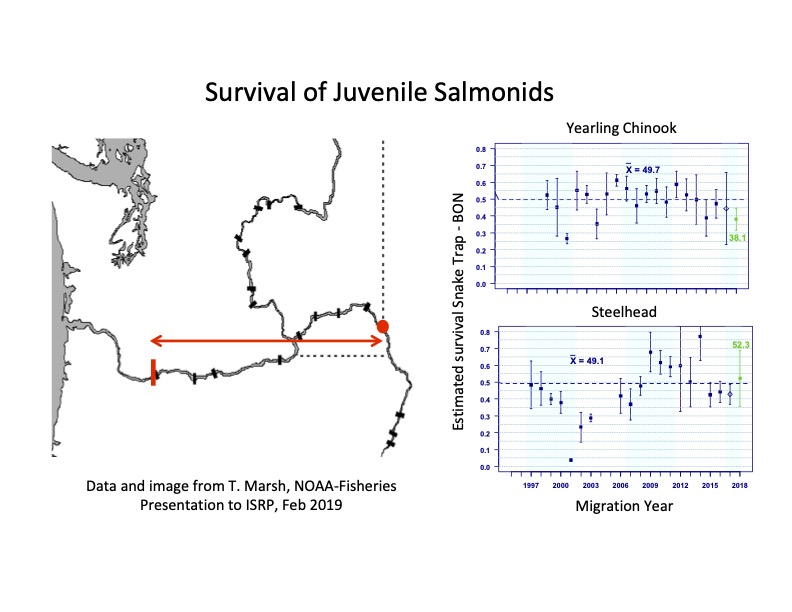forum
library
tutorial
contact

Salmon Recovery Efforts Are Happening
at the Local Level
by Mike Denny
Walla Walla Union-Bulletin, July 31, 2022
|
the film forum library tutorial contact |

|
Salmon Recovery Efforts Are Happening
by Mike Denny
|
 Starting in the late 1970s, as different salmon runs started to be considered for the Threatened and Endangered Species List, all kinds of folks began to have some serious discussions on the future of these northwest native fish species that so many people, ecological systems and wildlife depended on for their futures. Folks like sports and commercial fishermen, Northwest Native tribes, state and federal biologists, irrigators, farmers and conservationists.
Starting in the late 1970s, as different salmon runs started to be considered for the Threatened and Endangered Species List, all kinds of folks began to have some serious discussions on the future of these northwest native fish species that so many people, ecological systems and wildlife depended on for their futures. Folks like sports and commercial fishermen, Northwest Native tribes, state and federal biologists, irrigators, farmers and conservationists.
Western states, along with the U.S. Army Corps of Engineers, the U.S. Fish and Wildlife Service, the National Marine Fisheries Service and politicians were all scrabbling to agree on a way to save these valuable fish species that were now in sharp decline. It became a heated issue as people pushed and shoved to understand the complexity of the issue.
By the early 1990s, salmon run after salmon run ended up on the federally endangered species lists which restricted catches and water use and caused a lot of anger in many quarters. All kinds of proposals were made to save the salmon runs, from moratoriums on salmon fishing to cutting out gill netting, restricting marine territorial waters commercial limits and knocking out the dams on the Columbia River watershed to just let the salmon populations vanish. By the mid-1990s there were numerous court cases being fought by all sides. From out of this fog of battle stepped some forward-thinking folks who realized that what was happening was not working and that the fish would be gone by the time all the litigation was over.
Led by William Ruckelshaus and Norm Dicks, a group of fishing interests, tribes, conservationists, timber interests and state and federal natural resource agencies decided that in order to save the remnants of the salmon runs from extinction they had to work together and the whole effort had to be from the bottom up, from the people. So, in 1999 plans were set in motion to establish seven salmon recovery boards across the state of Washington.
In 2002 the Snake River Salmon Recovery Board was established across Walla Walla, Columbia, Garfield, Asotin and Whitman counties to create and restore the salmon runs in the rivers and streams of the northern Blue Mountains in the Columbia/Snake River water shed. The Snake River Salmon Recovery Board is made up of two citizen volunteer representatives from each county.
These county reps are appointed by the county commissioners from each county. There is also one county commissioner from each county, and representatives of the Confederated Tribes of the Umatilla Indian Reservation with the Nez Perce Tribe also serve as technical advisers. These native tribal representatives are on this board because of the 1855 treaty that set this region as part of their ceded lands and their interest in restoring salmon runs. Salmon are part of who the native people are as well as part of their spiritual beliefs.
The voting members make decisions based on evidence from scientific discovery and established data. There is a paid executive director and two support staff that provide data and reports.. A rotating chairman from the board runs the monthly meetings. There are good healthy discussions on project choices based on what the most recent data suggests as the best-informed options. This board strives for healthy, sustainable salmon populations in the Snake River system.
Six of the seven recovery boards are citizen-managed and directed, with the exception of the Puget Sound region, which is its own state agency. Boards receive state and federal funding. The local Snake River Salmon Recovery Board is funded to the tune of approximately $2.4 million.
A large portion of these funds go to restore streams and rivers in the basins such as the Tucannon, Grand Ronde, Walla Walla and Mill Creek, to name a few. This local board strives to select those project proposals that will provide the greatest good for the future of salmon in this region.
learn more on topics covered in the film
see the video
read the script
learn the songs
discussion forum
